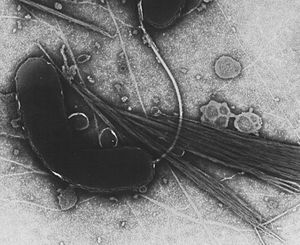Vibrionaceae
| Vibrionaceae | ||||||||||||
|---|---|---|---|---|---|---|---|---|---|---|---|---|

Vibrio cholerae |
||||||||||||
| Systematics | ||||||||||||
|
||||||||||||
| Scientific name | ||||||||||||
| Vibrionaceae | ||||||||||||
| Véron 1965 |
The Vibrionaceae form a family within the Gammaproteobacteria and are the only family of the order Vibrionales .
They are Gram-negative , fermenting , facultative anaerobic bacteria. They are oxidase-positive and have one or more flagella , mostly polar . The bacteria are found in fresh and salt water. Different types, such as B. Vibrio cholerae , are pathogenic. Most of the bacteria capable of bioluminescence belong to this family and live in symbiosis with deep-sea animals. Members of this family can make tetrodotoxin , an alkaloid, and powerful neurotoxin . These bacteria live in symbiosis with fish of the Tetraodontiformes family , such as B. the puffer fish .
Systematics
The following genera belong to Vibrionaceae:
- Allomonas
- Catenococcus
- Enterovibrio
- Ferrania
- Grimontia
- Listionella
- Photobacterium
- Photococcus
- Salinivibrio
- Vibrio
Synonyms:
- Enhydrobacter is now considered a Moraxellaceae found
- All species of the genera Beneckea and Lucibacterium are considered synonyms of Vibrio .
- The genera Aeromonas and Plesiomonas are now placed in the family Aeromonadaceae .
swell
- ^ National Center for Biotechnology Information (NCBI) as of July 2007.
literature
- Michael Madigan, John Martinko: Brock Biology of Microorganisms , 11th Edition. Prentice Hall, 2005, ISBN 0-13-144329-1